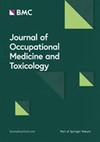Physical workload and cardiopulmonary parameters in relation to individual capacity of bulk waste workers – a cross-sectional field-study
IF 2.7
4区 医学
Q2 PUBLIC, ENVIRONMENTAL & OCCUPATIONAL HEALTH
Journal of Occupational Medicine and Toxicology
Pub Date : 2023-12-15
DOI:10.1186/s12995-023-00389-z
引用次数: 0
Abstract
Waste collection is considered particularly heavy work, although no previous study has yet investigated the strain of bulk waste collection. The aim of this study is to determine the workload of bulk waste workers in practice. We conducted a cross-sectional field-study. Fourteen male volunteers from the bulk waste collection of the municipal sanitation department in Hamburg, Germany, were included. Performance was determined by cardiopulmonary exercise testing under laboratory conditions. During the shift, each worker was accompanied by a researcher, and heart rate (HR) was recorded under field conditions using an HR watch with a belt system. We examined mean HR, relative heart rate (RHR), relative aerobic strain (RAS), calculated oxygen uptake ( $$\mathrm{\overset{.}{V}O}_2$$ ) and individual ventilatory threshold 1 (VT1) as parameters of workload during their daily work. During the shift, HR was scaled: 102 bpm (SD 10.2), RHR: 36.9%, $$\mathrm{\overset{.}{V}O}_2$$ : 1267 ml/min (SD 161), RAS: 49.4% (SD 9.3), and $$\mathrm{\overset{.}{V}O}_2$$ in relation to VT1: 75% (SD 18.5). There was no significant difference between oxygen consumption during the main task of lifting and carrying bulky waste and the individual $$\mathrm{\overset{.}{V}O}_2$$ at VT1. Although the burden of the main task of lifting and carrying bulky waste is very high (at VT1 for more than 3 h), interruptions from other tasks or formal breaks spread the burden over the entire shift. The total workload exceeded most recommendations in the literature across the different work periods. However, the total burden remains below VT1, the only parameter that takes individual endurance performance into account. We recommend again VT1 as an individual upper limit for prolonged occupational work.与散装废物工人个人能力有关的体力工作量和心肺参数--一项横断面实地研究
垃圾收集被认为是一项特别繁重的工作,但此前还没有研究调查过大宗垃圾收集工作的压力。本研究旨在确定散装垃圾工人的实际工作量。我们进行了一项横断面实地研究。研究对象包括 14 名来自德国汉堡市环卫部门从事散装垃圾收集工作的男性志愿者。我们在实验室条件下通过心肺运动测试确定了他们的工作表现。在轮班期间,每名工人都有一名研究人员陪同,并在现场条件下使用带皮带系统的心率表记录心率(HR)。我们研究了平均心率、相对心率(RHR)、相对有氧负荷(RAS)、计算摄氧量($$\mathrm{\overset{.}{V}O}_2$$)和个体通气阈值 1(VT1),作为日常工作中的工作量参数。轮班期间,心率为102 bpm (SD 10.2), RHR: 36.9%, $$\mathrm{\overset{.}{V}O}_2$$ : 1267 ml/min (SD 161), RAS:49.4%(SD 9.3),与 VT1 有关的 $$\mathrm{\overset{.}{V}O}_2$$:75%(SD 18.5)。在 VT1 时,搬运大件废物这一主要任务的耗氧量与个人的 $$\mathrm{/overset{.}{V}O}_2$ 之间没有明显差异。虽然搬运大件垃圾的主要工作负担很重(在 VT1 的工作时间超过 3 小时),但其他工作的中断或正式休息会将负担分摊到整个班次。在不同的工作时段,总工作量超过了大多数文献中的建议。然而,总负担仍低于 VT1,这是唯一考虑到个人耐力表现的参数。我们再次建议将 VT1 作为个人长期职业工作的上限。
本文章由计算机程序翻译,如有差异,请以英文原文为准。
求助全文
约1分钟内获得全文
求助全文
来源期刊

Journal of Occupational Medicine and Toxicology
PUBLIC, ENVIRONMENTAL & OCCUPATIONAL HEALTH-
CiteScore
6.00
自引率
0.00%
发文量
23
审稿时长
19 weeks
期刊介绍:
Aimed at clinicians and researchers, the Journal of Occupational Medicine and Toxicology is a multi-disciplinary, open access journal which publishes original research on the clinical and scientific aspects of occupational and environmental health.
With high-quality peer review and quick decision times, we welcome submissions on the diagnosis, prevention, management, and scientific analysis of occupational diseases, injuries, and disability. The journal also covers the promotion of health of workers, their families, and communities, and ranges from rehabilitation to tropical medicine and public health aspects.
 求助内容:
求助内容: 应助结果提醒方式:
应助结果提醒方式:


